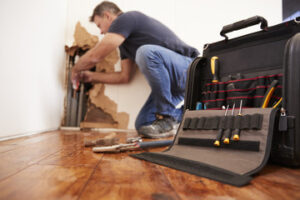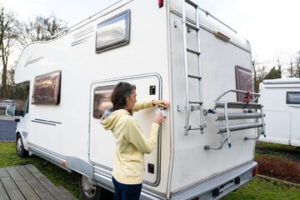During Robotic Hernia Surgery your surgeon sits down at a console next to you and operates through a few small incisions. The surgeon is able to use tiny, precise instruments with a 3D ultrahigh-definition camera for an extremely clear view.

In hernia surgery, the surgeon uses a robotic system to access the area. The robot’s advanced camera provides a clear, detailed view of the surgical site. Its arms hold small surgical instruments, and the surgeon controls them seated at the da Vinci console. This means less muscle and tissue damage, fewer complications and shorter recovery time.
The da Vinci system is used mainly for hernias in the belly button (umbilical hernias) and hernias in the lower abdomen or groin (inguinal hernias). While the procedure is similar to laparoscopic hernia repair, it is more precise. For example, it allows the doctor to reach areas in the abdominal wall that are not possible with traditional techniques. The smaller surgical tools and high degree of precision mean that the hernia repairs are more effective, which reduces the risk that a hernia will return.
A hernia can cause pain, discomfort and swelling. It can also lead to future problems if left untreated. In fact, a hernia can become so severe that it requires emergency surgery. That’s why it’s important to have hernia surgery at the first sign of a hernia.
During the hernia repair, the surgeon inserts a piece of mesh into the hernia site to prevent it from bulging again. Then, the surgeon uses sutures to close the hernia. The patient’s recovery is much quicker than with traditional hernia repair and there is less pain, bruising and swelling.
Many patients put off hernia repair because of fear of painful recovery and lengthy hospital stays. However, hernia surgery can be a safe and life-changing procedure that can relieve pain and prevent future hernias.
A hernia is one of the most common health problems and many people suffer from it. Hernias can be painful and can lead to serious complications, so it’s important to get hernia surgery as soon as possible. Robotic hernia surgery is an excellent option for hernias because it is minimally invasive and has a quick recovery time. It’s an excellent option for patients who want to return to their normal lives quickly. This is especially true for people who are active and don’t want to change their lifestyles after a hernia.
Techniques
The robotic technique involves the use of a console that the surgeon controls with their hands and small instruments inserted through tiny cuts in the abdomen. The robot enables the surgeon to make precise movements and repair hernias that are difficult to fix with laparoscopic techniques. In addition, robotic hernia surgery is often performed faster than laparoscopic procedures. Patients who have robotic hernia repair can go home the same day, with fewer restrictions on activity.
During the procedure, the surgeon uses a high-definition camera to view the surgical site. This allows them to see better than with laparoscopy. It also allows them to place the stitches with greater accuracy. Because of this, robotic hernia surgery typically has fewer complications than traditional laparoscopy and is less likely to require revision.
The procedure is performed through three small ports, compared to the five- to six-inch incision used with laparoscopic hernia repair. The robot’s 3-D camera provides clear images and helps the surgeon perform the operation with precision. It also allows the surgeon to view the hernia from all angles, making the procedure safer than laparoscopic hernia repair.
A mesh is inserted into the hernia sac. Using a large-pore, MRI-visible mesh (Dynamesh, Aachen, Germany), the hernia is fixed at four points: (a) symphysis, (b) space of Retzius, (c) the fascia of the rectus muscle and (d) the iliac fascia. Loose absorbable sutures are used to attach the mesh to the abdominal wall.
In a prospective head-to-head comparison of robotic and laparoscopic hernia repair, we found that early clinical outcomes were similar for both approaches in terms of postoperative pain, quality of life, mobility, wound morbidity and cosmesis. However, the robotic approach was more expensive and required a longer operating time, and resulted in greater surgeon frustration. It also failed to provide objective ergonomic benefits for the surgeon compared with the laparoscopic platform.
Preparation
Most hernia procedures are performed on an outpatient basis and patients are discharged the same day of the operation. Pre-operative preparation will include bloodwork and a medical evaluation based on your age and condition. Your doctor will explain the procedure to you and you will need to sign a form that states you understand the risks and benefits of hernia surgery.
During the hernia repair, three small incisions (about half an inch) are made in the belly area. A tube with a camera is then inserted into one of the incisions and the area is displayed on a video screen. A surgeon sitting nearby controls a system that translates finger and hand movement to movements of the instruments, which may include different tissue grasping devices, scissors, and needle holders. Unlike laparoscopy, robotic surgical instruments are positioned by the surgeon and are not moved by the patient’s upper extremity movements, which reduces surgery time.
Once the hernia is exposed, a piece of synthetic mesh is placed in the abdominal wall behind the hernia and sewn to the muscle. This is a very delicate process, since there are many vital structures close to the area of hernia repair including the urinary bladder, the intestines, blood vessels and nerves. Using the robot, the surgeon can work very carefully to avoid injury to these structures.
Another benefit of robotic hernia surgery is avoiding the use of large amounts of sutures, which can lead to increased postoperative pain and decreased mobility. A hernia repair using the Da Vinci robot requires fewer stitches and is much quicker to recover from than traditional open surgery.
Generally, recovery from hernia surgery is similar to recovery from any other surgery. You will likely need to restrict your activities and eat differently until the wound heals. You will also need to be careful not to strain or irritate the surgical site. Your doctor will provide you with specific instructions for caring for the hernia surgery wound.
Some people develop a feeling of numbness or heaviness in the area where the hernia was repaired. This is usually due to fluid collecting within the previous space of the hernia and will disappear with time. In the meantime, you can use over-the-counter pain medications to manage any discomfort you experience. Typically, you will need to schedule a follow-up appointment with your doctor to ensure that the hernia is completely healed.
Recovery
Unlike traditional surgery, robotic hernia repair typically requires less time in the hospital, with many patients discharged on the same day or the next. For adults who are able to resume light exercise, such as walking, after a week, the recovery process can be even faster.
Patients can expect to return to normal activities, including work, within a few weeks after their hernia surgery. However, adults should avoid any activities that involve lifting heavy objects or straining. In addition, it is a good idea to stay hydrated and maintain a diet that includes high-fiber foods.
For robotic hernia repairs, surgeons make six small cuts in the abdomen, each less than an inch wide. They then insert a thin tube with a camera attached, called a laparoscope, into the abdominal cavity through one of these incisions. This enables them to see the hernia and its surrounding tissue.
Using a console in the operating room, doctors then manipulate the robotic “arms” to perform hernia repairs with greater precision than with laparoscopic or open surgical techniques. The doctors can see the area they are working on through a high-definition 3D camera, giving them better visualization of the tissues they’re cutting or stitching.
In contrast to conventional hernia repair, robotic surgery allows for fewer scars and faster recovery time. It also has a lower risk of infection and can lead to less pain after surgery.
Patients should expect a period of soreness after hernia surgery, but this should subside after a few days. While prescription pain medications may be necessary for some individuals, most find that over-the-counter analgesics are sufficient.
For optimal results, it’s important to follow your doctor’s postoperative instructions. Most people will need to refrain from strenuous activity for about a week, but should gradually resume their activities over the course of several weeks. The most important thing is to make sure that hernia pain doesn’t interfere with daily life.


